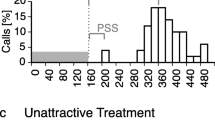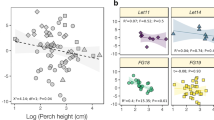Abstract
Competition for mates often occurs in social settings composed of many displaying males. While this poses some special challenges for communication, the proximity of other males may also provide information that chorus participants may use to adaptively adjust their calling behavior to the local level of competition. Conducting behavioral observations in natural choruses as well as playback experiments with focal males, I investigated socially mediated plasticity in the calling behavior of a neotropical gladiator frog, Hypsiboas rosenbergi. In natural choruses, male call rate was negatively correlated with the distance to the nearest calling neighbor, suggesting that the presence and distance of competing males influences call rate in this species. In a playback experiment that tested for the effect of the presence and competitiveness of rivals, H. rosenbergi males proved able to quickly notice changes in their acoustic environment and to respond to those changes in a graded fashion. As competition increased (either by increasing the number or attractiveness of the simulated rivals), males raised their calling rate; as competition was reduced, males lowered their calling rate. This indicates that males can perceive changes in their social environment and modify their calling behavior in ways that reflect the level of competition in the chorus. This socially mediated plasticity in calling behavior may help males to economize their energy reserves.




Similar content being viewed by others
References
Andersson MB (1994) Sexual selection. Princeton University Press, Princeton
Arak A (1983) Vocal interactions, call matching and territoriality in a Sri Lankan treefrog, Philautus leucorhinus (Rhacophoridae). Anim Behav 31:292–30
Bastos RP, Alcantara MB, Morais AR, Lingnau R, Signorelli L (2011) Vocal behaviour and conspecific call response in Scinax centralis. Herpetol J 21:43–50
Bee MA (2007) Selective phonotaxis by male wood frogs (Rana sylvatica) to the sound of a chorus. Behav Ecol Sociobiol 61:955–966
Benedix JH Jr, Narins PM (1999) Competitive calling behavior by male treefrogs, Eleutherodactylus coqui (Anura: Leptodactylidae). Copeia 1999:1118–1112
Bernal XE, Akre KL, Baugh AT, Rand AS, Ryan MJ (2009) Female and male behavioural response to advertisement calls of variable complexity in túngara frogs, Physalaemus pustulosus. Behav Ecol Sociobiol 63:1269–1279
Bosch J, Márquez R (1996) Acoustic competition in male midwife toads Alytes obstetricans and Alytes cisternasii: response to neighbor size and calling rate. Implications for female choice. Ethology 102:841–855
Brenowitz EA (1989) Neighbor call amplitude influences aggressive behavior and intermale spacing in choruses of the Pacific treefrog (Hyla regilla). Ethology 83:69–79
Brepson L, Voituron Y, Lengagne T (2013) Condition-dependent ways to manage acoustic signals under energetic constraint in a tree frog. Behav Ecol 24:488–496
Brooke PN, Alford RA, Schwarzkopf L (2000) Environmental and social factors influence chorusing behaviour in a tropical frog: examining various temporal and spatial scales. Behav Ecol Sociobiol 49:79–97
Byrne PG (2008) Strategic male calling behavior in an Australian terrestrial toadlet (Pseudophryne bibronii). Copeia 2008:57–63
Dapper AL, Baugh AT, Ryan MJ (2011) The sounds of silence as an alarm cue in túngara frogs, Physalaemus pustulosus. Biotropica 43:380–385
Gerhardt HC, Huber F (2002) Acoustic communication in insects and anurans: common problems and diverse solutions. University of Chicago Press, Chicago
Gerhardt HC, Daniel RE, Perrill SA, Schramm S (1987) Mating behaviour and male mating success in the green treefrog. Anim Behav 35:1490–1503
Gerhardt HC, Roberts JD, Bee MA, Schwartz JJ (2000a) Call matching in the quacking frog (Crinia georgiana). Behav Ecol Sociobiol 48:243–251
Gerhardt HC, Tanner SD, Corrigan CM, Walton HC (2000b) Female preferences based on call duration in the gray treefrog (Hyla versicolor). Behav Ecol 11:663–669
Giasson LOM, Haddad CFB (2006) Social Interactions in Hypsiboas albomarginatus (Anura: Hylidae) and the significance of acoustic and visual signals. J Herpetol 40:171–180
Given MF (1993) Vocal interactions in Bufo woodhousii fowleri. J Herpetol 27:447–452
Goutte S, Kime NM, Argo IV, Argo TF, Ryan MJ (2010) Calling strategies of male túngara frogs in response to dynamic playback. Behaviour 147:65–83
Greenfield MD (1994) Cooperation and conflict in the evolution of signal interactions. Annu Rev Ecol Syst 25:97–126
Höbel G (1999) Facultative nest construction in the gladiator frog Hyla rosenbergi (Anura: Hylidae). Copeia 1999:797–801
Höbel G (2000) Reproductive ecology of Hyla rosenbergi in Costa Rica. Herpetologica 56:446–454
Höbel G (2008) Plasticity and geographic variation in the reproductive ecology of gladiator frogs, particularly Hypsiboas rosenbergi. In: Natural and cultural history of the Golfo Dulce Region, Costa Rica. Pp 329–334. Biologiezentrum der OÖ Landesmuseen, Austria
Höbel G, Gerhardt HC (2007) Sources of selection on signal timing in a tree frog. Ethology 113:973–982
Lopez PT, Narins PM, Lewis ER, Moore SW (1988) Acoustically induced call modification in the white-lipped frog, Leptodactylus albilabris. Anim Behav 36:1295–1308
Kluge AG (1981) The life history, social organisation and parental behavior of Hyla rosenbergi, a nest-building gladiator frog. Miscellaneous Publications of the Museum of Zoology, University of Michigan, 160:1–170
Martins M (1993) Observations on nest dynamics and embryonic and larval development in the nest building Gladiator frog, Hyla faber. Amphibia-Reptilia 14:411–421
Murphy CG (1994) Determinants of chorus tenure in barking treefrogs (Hyla gratiosa). Behav Ecol Soc 34:285–294
Pfennig KS, Rapa K, McNatt R (2000) Evolution of male mating behavior: male spadefoot toads preferentially associate with conspecific males. Behav Ecol Sociobiol 48:69–74
Rosso A, Castellano S, Giacoma C (2006) Preferences for call spectral properties in Hyla intermedia. Ethology 112:599–607
Ryan MJ, Keddy-Hector A (1992) Directional patterns of female mate choice and the role of sensory biases. Am Nat 139:S4–S35
Ryan MJ, Rand AS (1998) Evoked vocal response in male tungara frogs: pre-existing biases in male responses? Anim Behav 56:1509–1516
Ryan MJ, Tuttle MD, Taft LK (1981) The costs and benefits of frog chorusing behavior. Behav Ecol Sociobiol 8:273–278
Schwartz JJ (1986) Male calling behaviour and female choice in the neotropical treefrog Hyla microcephala. Ethology 73:116–127
Schwartz JJ, Buchanan BW, Gerhardt HC (2002) Acoustic interactions among male gray treefrogs, Hyla versicolor, in a chorus setting. Behav Ecol Sociobiol 53:9–19
Swanson EM, Tekmen SM, Bee MA (2007) Do female frogs exploit inadvertent social information to locate breeding aggregations? Can J Zool 85:921–932
Taigen TL, Wells KD (1985) Energetics of vocalization by an anuran amphibian (Hyla versicolor). J Comp Physiol B 155:163–170
Tarano Z (2002) Vocal responses to conspecific call variation in the neotropical frog Physalaemus enesefae. J Herpetol 33:615–620
Tárano Z, Fuenmayor E (2009). Calling patterns in male responses to conspecific playbacks in the Johnstone’s Whistling frog Eleutherodactylus johnstonei. Ethology 115:747–757
Toledo LF, Haddad CF (2005) Acoustic repertoire and calling behavior of Scinax fuscomarginatus (Anura, Hylidae). J Herpetol 39:455–464
Wells KD (1988) The effects of social interactions on anuran vocal behavior. In: Fritszch B, Wilczynski W, Ryan MJ, Hetherington T, Walkowiak W (eds) The evolution of the amphibian auditory system. Wiley, New York, pp 433–454
Wells KD (2001) The energetics of calling in frogs. In: Ryan MJ (ed) Anuran communication Smithsonian Institution, Washington, pp 45–60
Wells KD (2007) The ecology and behavior of amphibians. University of Chicago Press
Wells KD, Greer BJ (1981) Vocal responses to conspecific calls in a neotropical Hylid frog, Hyla ebraccata, Copeia 1981:615–624
Wells KD, Schwartz JJ (2007) The behavioral ecology of anuran communication. Pp. 44–86, In: Narins, PM, Feng AS, Fay RR, Popper AN (eds) Hearing and sound communication in amphibians. Springer Handbook of Auditory Research (Vol. 28). Springer-Verlag, New York
Wells KD, Taigen TL (1986) The effect of social interactions on calling energetics in the gray treefrog (Hyla versicolor). Behav Ecol Sociobiol 19:9–18
Acknowledgments
I thank Günter Ehret for loan of equipment, and the Verein Regenwald der Österreicher for permission to work at La Gamba Biological Station. Rafael L. Rodríguez S. helped with logistics and improved earlier drafts of the manuscript.
Author information
Authors and Affiliations
Corresponding author
Rights and permissions
About this article
Cite this article
Höbel, G. Socially mediated plasticity of chorusing behavior in the gladiator frog Hypsiboas rosenbergi . acta ethol 18, 145–152 (2015). https://doi.org/10.1007/s10211-014-0199-z
Received:
Revised:
Accepted:
Published:
Issue Date:
DOI: https://doi.org/10.1007/s10211-014-0199-z




